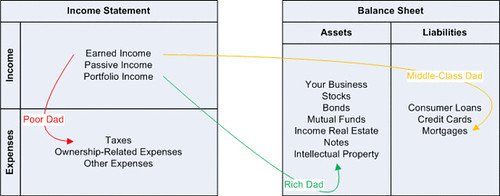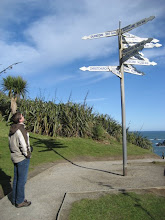
If you want a lesson in confusion, simply look up the words "asset" and "liability" in the dictionary.... An asset is something that puts money in my pocket. A liability is something that takes money out of my pocket. This is really all you need to know. If you want to be rich, simply spend your life buying assets. If you want to be poor or middle class, spend your life buying liabilities.Robert T. Kiyosaki, Rich Dad, Poor Dad: What the Rich Teach Their Kids about Money--That the Poor and Middle Class Do Not!
Being from a middle-class background, the subtitle of Rich Dad, Poor Dad caught my eye in the Barnes and Noble personal finance area Saturday. As several responses to Don't Let's Go to the Dogs Tonight show, I like anecdotes. I read with interest Kiyosaki's contrast between his rich capitalist businessman dad and his poor socialist employee dad during his childhood in Hawai`i.
The folksy capitalist philosophy in Rich Dad, Poor Dad begins with an income statement and balance sheet. Kiyosaki simplifies each into two boxes with a line in the middle: for the income statement the line is horizontal, and for the balance sheet the line is vertical.
In the top of the income statement are earned income ("work for owner"), passive income, and portfolio income. In the bottom of the income statement are taxes ("work for government"), ownership-related expenses, and other expenses. Subsequent diagrams expand on portfolio income (dividends, interest, rental income, royalties), ownership-related expenses (mortgage payments, real property taxes, insurance, maintenance, utilities), and other expenses (fixed expenses, food, clothing, fun).
In the left side of the balance sheet are assets which create income--your business, stocks, bonds, mutual funds, income-generating real estate, notes, and intellectual property. In the right side of the balance sheet are liabilities ("work for bank") which create expenses--consumer loans, credit cards, and mortgages.
Poor Dad says, "Go to school, get good grades, and find a safe secure job." In other words, concentrate on earned income in the top of the income sheet. Rich Dad says, "The rich don't work for money, they have their money work for them." In other words, concentrate on passive and portfolio income in the top of the income sheet--with passive income being faster. In the bottom of the income sheet, the government taxes earned income the most, and passive income the least.
Rich Dad, Poor Dad consequently characterizes classes using these boxes. The earned income of the poor pays expenses in the income statement and little affects the balance sheet. For the middle class, expenses and taxes rise with income in the income statement, as do liabilities incurred on the balance sheet. The income of the rich purchases income-producing assets, with less rise in expenses or liabilities. (For example, a corporation deducts expenses from income before taxation.) In this way they practice the "pay yourself first" advice of The Richest Man in Babylon.
The challenge is defining "your business." Kiyosaki writes, "If I have to work there, it's not a business. It becomes my job." Timothy Ferriss has similar suggestions for a "muse" in the "Income Autopilot" chapters in "Step III: A is Automation" of The 4-Hour Workweek.
The goal for both Ferriss and Kiyosaki is freedom. The latter explains his wants:
I want to be free to travel the world and live in the lifestyle I love. I want to be young when I do this. I want to simply be free. I want control over my time and my life. I want money to work for me.Readers of this blog will recognize this desire to travel and live abroad.
[Added diagram and corrected word.]

3 comments:
I just discovered John T. Reed has an analysis of Robert T. Kiyosaki's book
Rich Dad, Poor Dad.
The blog has a simpler diagram based upon similar ideas.
I m not used to of reading very much books but this book do some kind of magic I finished it in 2 days and it actually have a lot of knowledge one should know....:)
It teaches how to earn invest and play with money.....Thumbs up for the Author..
Post a Comment